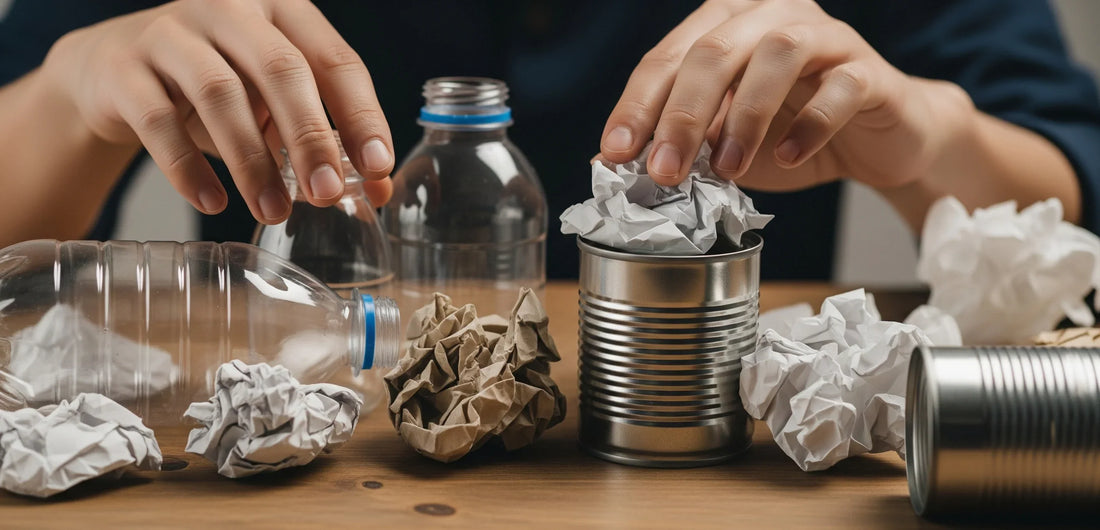
Upcycled ASMR: Turning Trash into Satisfying Sound Art
Share
The intersection of environmental consciousness and ASMR has birthed a fascinating subcategory: upcycled sound art that transforms discarded materials into deeply satisfying auditory experiences. This movement challenges both our perceptions of waste and our understanding of what constitutes pleasant, trigger-worthy sounds.
The Hidden Audio Potential of Discarded Materials
Every piece of "trash" possesses unique acoustic properties shaped by its material composition, structural design, and previous use. Plastic containers create different resonances than glass bottles; cardboard produces distinct scratching and tearing sounds compared to paper; metal objects generate percussive tones that vary with density and thickness.
Upcycled ASMR artists discover that items designed for other purposes often produce unexpectedly satisfying sounds. Bubble wrap creates perfect popping sequences, styrofoam containers generate distinctive squeaking when compressed, and plastic bottles produce fascinating crinkle patterns when manipulated.
The process of sonic exploration itself becomes meditative. Examining discarded objects for their sound potential shifts focus from waste disposal to creative discovery, transforming our relationship with both consumption and disposal.
Acoustic Properties of Common Discarded Materials
Different waste materials excel at producing specific types of ASMR triggers:
- Plastic packaging: Crinkles, squeezes, and gentle tearing sounds with varying pitch ranges
- Glass containers: Tapping, clinking, and resonance effects that create bell-like tones
- Paper waste: Rustling, folding, and tearing with rich textural variation
- Cardboard: Deep, satisfying scratching surfaces and hollow percussion effects
- Metal cans: Precise tapping sounds and unique resonance chambers
- Fabric scraps: Brushing, rubbing, and folding sounds with soft, organic textures
The key lies in discovering each material's optimal manipulation techniques. Light pressure on plastic film creates different sounds than firm pressure; slow movements produce different textures than rapid ones.
Creating Intentional Sound Compositions
Successful upcycled ASMR requires thoughtful composition rather than random noise generation. Consider rhythm, dynamics, and progression when combining different waste materials. Start with gentle, introductory sounds, build complexity gradually, then return to simpler patterns for satisfying resolution.
Layer complementary materials to create rich soundscapes. Soft paper rustling can provide background texture while precise glass tapping delivers focused triggers. The contrast between organic and synthetic materials often produces particularly engaging combinations.
Record in quiet environments to capture subtle details that make upcycled sounds compelling. Quality earbuds become essential for listeners to appreciate the nuanced textures and delicate variations that distinguish intentional sound art from random noise.
The Environmental Psychology Connection
Upcycled ASMR addresses environmental anxiety by demonstrating positive relationships with waste materials. Instead of viewing discarded items as sources of guilt or environmental concern, this practice reframes them as creative resources and potential sources of joy.
The process mirrors broader sustainability principles: finding value in overlooked resources, extending material lifecycles, and discovering beauty in unexpected places. These psychological shifts can influence broader environmental attitudes and behaviors.
Many practitioners report increased awareness of the acoustic properties of everyday objects, leading to more mindful consumption habits and greater appreciation for the sensory richness of their physical environment.
Technical Considerations for Upcycled Recording
Recording upcycled ASMR presents unique challenges. Many waste materials produce sounds outside traditional ASMR frequency ranges – too high-pitched, too low, or too sudden. Proper microphone placement and audio processing become crucial for capturing optimal trigger responses.
Close-microphone techniques work well for delicate sounds like plastic film manipulation or paper folding. Distance recording better captures the spatial qualities of larger objects or percussive sounds from metal containers.
Post-production requires careful attention to frequency balance. Some upcycled materials produce harsh frequencies that need gentle filtering, while others generate such quiet sounds that they require amplification without introducing background noise.
Safety and Hygiene in Upcycled Sound Art
Working with discarded materials requires attention to cleanliness and safety. Thoroughly clean all items before use, remove sharp edges or dangerous components, and avoid materials that may contain harmful residues or toxic substances.
Consider the source and previous contents of containers. Food packaging generally presents fewer risks than industrial or chemical containers. When in doubt, choose materials with known, benign histories over mysterious discarded objects.
Wear appropriate protection when handling or modifying waste materials. Simple precautions like gloves and good ventilation allow safe exploration of upcycled sound possibilities.
Community Aspects of Upcycled ASMR
Upcycled ASMR fosters community engagement through shared discovery and collaborative creation. Groups can organize "sound scavenging" events where participants seek interesting acoustic materials together, sharing discoveries and techniques.
The accessible nature of source materials democratizes ASMR creation. Anyone can participate regardless of budget or access to specialized equipment. This inclusivity has led to diverse voices and innovative approaches within the upcycled ASMR community.
Documentation becomes important for building collective knowledge. Recording not just the final sounds but also the discovery and manipulation processes helps others learn techniques and find inspiration in their own waste streams.
Measuring Impact: Both Personal and Environmental
Track multiple benefits when engaging with upcycled ASMR. Personal measures include relaxation levels, creative satisfaction, and changed attitudes toward waste and consumption. Environmental measures might include reduced waste generation, increased recycling awareness, and greater mindfulness about material consumption.
Many practitioners report that upcycled ASMR changes their relationship with possessions and disposal. The practice encourages seeing potential value in items that might otherwise be discarded hastily.
The combination of creative satisfaction, environmental consciousness, and relaxation benefits creates a uniquely fulfilling practice that addresses multiple wellness dimensions simultaneously.
Expanding Beyond Individual Practice
Upcycled ASMR principles can extend to educational settings, teaching both acoustic awareness and environmental stewardship. The hands-on exploration of material properties provides tangible learning experiences about both sound physics and waste reduction strategies.
Art therapy applications show promise, as the process combines creative expression, sensory exploration, and environmental mindfulness in ways that can be particularly healing for individuals dealing with environmental anxiety or creative blocks.
The practice ultimately challenges conventional boundaries between art, wellness, and environmental action, demonstrating that sustainable living can be both personally rewarding and aesthetically satisfying. Trash becomes treasure not through monetary value but through sensory appreciation and creative transformation.
